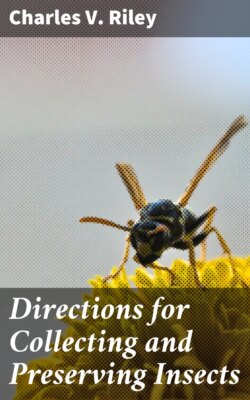Читать книгу Directions for Collecting and Preserving Insects - Charles V. Riley - Страница 7
На сайте Литреса книга снята с продажи.
SCOPE AND IMPORTANCE OF ENTOMOLOGY.
ОглавлениеTable of Contents
But few words are necessary to indicate the importance of entomology, especially to the farming community; for while insects play a most important part in the economy of nature and furnish us some valuable products and otherwise do us a great deal of indirect good, yet they are chiefly known by the annoyances they cause and by the great injury they do to our crops and domestic animals. Hence some knowledge of insects and how to study them becomes important, almost necessary, to every farmer.
The scope of the science may best be indicated by a statement of the number of species existing, as compared with other animals. The omnipresence of insects is known and felt by all; yet few have any accurate idea of the actual numbers existing, so that some figures will not prove uninteresting in this connection. Taking the lists of described species, and the estimates of specialists in the different orders, it is safe to say that about thirty thousand species have already been described from North America, while the number of species already described or to be described in the Biologia Centrali-Americana, i.e., for Central America, foot up just about the same number, Lord Walsingham having estimated them at 30,114 in his address as president of the London Entomological Society two years ago, neither the Orthoptera nor the Neuroptera being included in this estimate. By way of contrast the number of mammals, birds, and reptiles to be described from the same region, is interesting. It foots up 1,937, as follows:
Mammals, 180; birds, 1,600; reptiles, 157.
If we endeavor to get some estimate of the number of insects that occur in the whole world, the most satisfactory estimates will be found in the address just alluded to, and in that of Dr. David Sharp before the same society. Linnæus knew nearly 3,000 species, of which more than 2,000 were European and over 800 exotic. The estimate of Dr. John Day, in 1853, of the number of species on the globe, was 250,000. Dr. Sharp's estimate thirty years later was between 500,000 and 1,000,000. Sharp's and Walsingham's estimates in 1889 reached nearly 2,000,000, and the average number of insects annually described since the publication of the Zoölogical Record, deducting 8 per cent for synonyms, is 6,500 species. I think the estimate of 2,000,000 species in the world is extremely low, and if we take into consideration the fact that species have been best worked up in the more temperate portions of the globe, and that in the more tropical portions a vast number of species still remain to be characterized and named, and if we take further into consideration the fact that many portions of the globe are yet unexplored, entomologically, that even in the best worked up regions by far the larger portion of the Micro-Hymenoptera and Micro-Diptera remain absolutely undescribed in our collections, and have been but very partially collected, it will be safe to estimate that not one-fifth of the species extant have yet been characterized or enumerated. In this view of the case the species in our collections, whether described or undescribed, do not represent perhaps more than one-fifth of the whole. In other words, to say that there are 10,000,000 species of insects in the world, would be, in my judgment, a moderate estimate.
